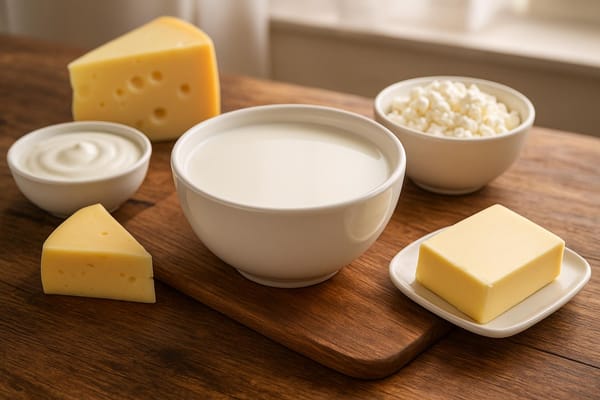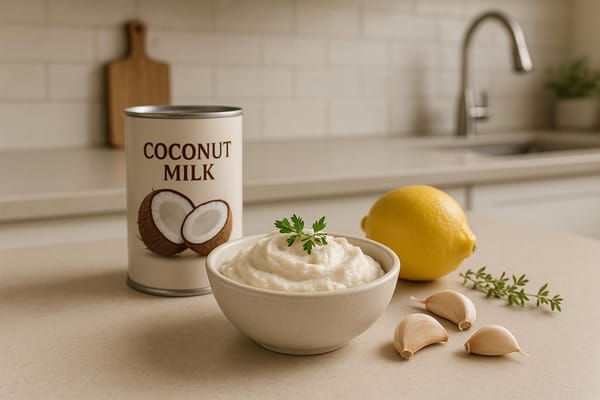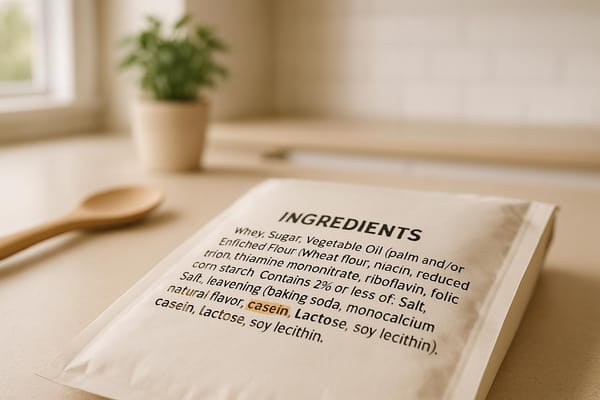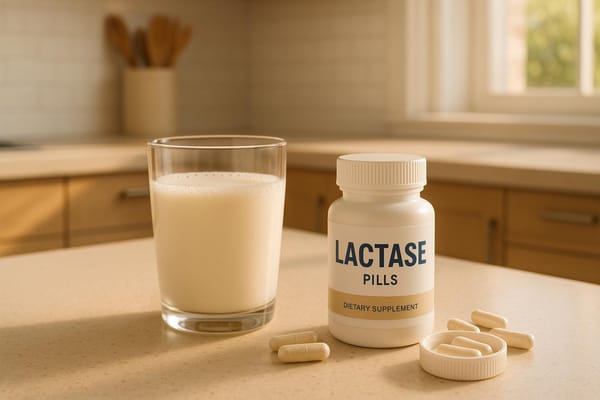Ultimate Guide to Lactose-Free Protein Powders
Explore lactose-free protein powders, their benefits, types, and tips for choosing the right one to support muscle recovery without digestive issues.
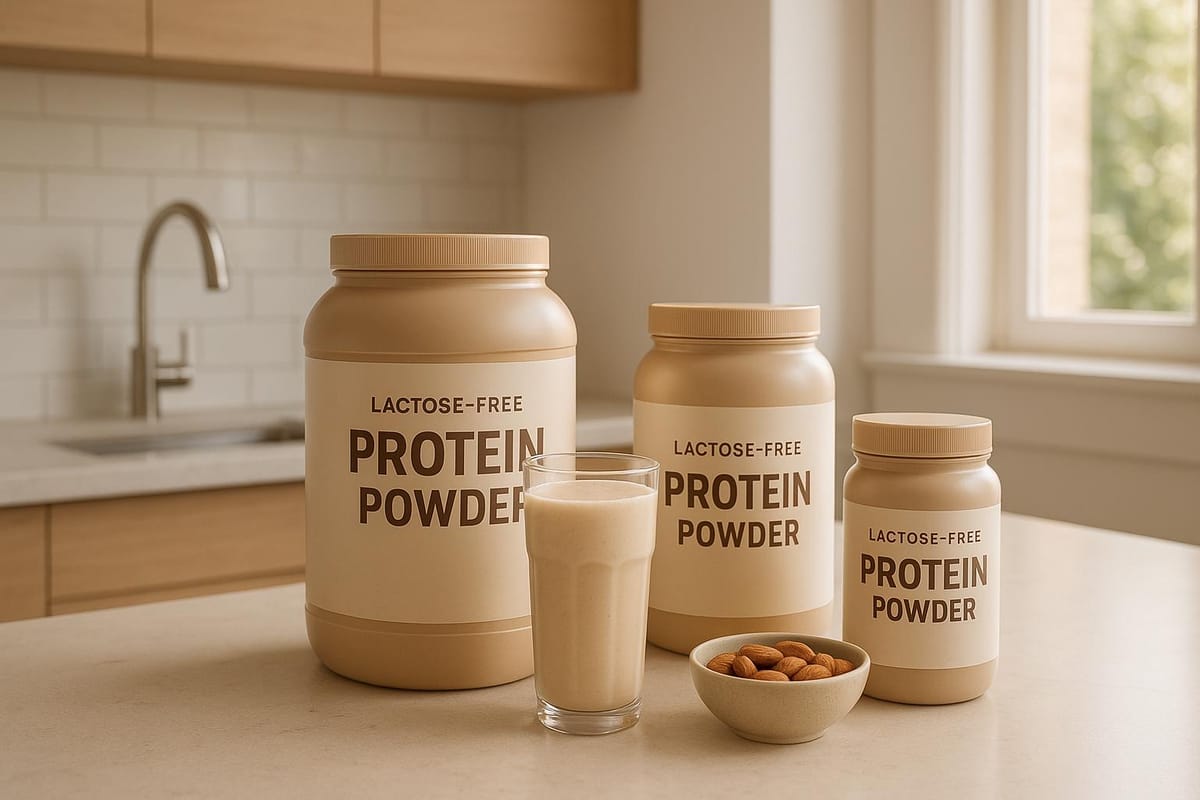
What You’ll Learn:
- Types of Lactose-Free Protein: Dairy-based (whey isolate, hydrolysate) or plant-based (pea, rice, soy, hemp).
- Who Benefits: Perfect for 65% of adults who are lactose intolerant, especially East Asians (up to 100% affected).
- Key Advantages:
- Eases digestion.
- Supports muscle recovery.
- Fits dietary restrictions.
- Helps with weight management.
Quick Comparison:
| Type | Protein per Serving | Digestibility | Best For |
|---|---|---|---|
| Whey Isolate | 25–30 g | ~90% | Muscle recovery, post-workout |
| Pea + Rice Blend | 20–24 g | ~80% | Vegans, plant-based diets |
| Multi-Plant Blend | 20–30 g | ~80% | Balanced amino acid profile |
Pro Tip: Look for third-party certifications (NSF, Informed Sport) and simple ingredient lists for the best quality.
Keep reading to learn how to pick the right product, improve absorption, and maximize results with lactose-free protein powders.
Whey Protein Alternatives if You're Lactose Intolerant | Nutrition Coach Explains | Naked Nutrition
Common Types of Lactose-Free Protein
There’s a wide variety of lactose-free protein options available, both from dairy and plant sources, that can help you meet your fitness goals without digestive discomfort.
Dairy-Based Options
Dairy-based protein powders are specially processed to remove or break down lactose, making them a good choice for those with lactose sensitivity. Whey protein isolate is one such option, containing about 90% protein and very little lactose due to thorough filtration techniques.
If whey isolate still doesn’t sit well with you, whey protein hydrolysate might be a better fit. This version is partially broken down into smaller protein fragments, which makes it easier to digest. However, it may slightly compromise some nutrient benefits due to the processing involved.
One standout product in this category is Isopure Whey Protein Isolate, which offers 25 grams of protein per serving with zero carbs or fats, thanks to its advanced filtration process.
If you’re looking for more variety, plant-based proteins are another excellent lactose-free option.
Plant-Based Options
Plant-based proteins are naturally free of lactose and often come with added perks like lower fat and calorie content. Here’s a quick look at some popular choices:
| Protein Source | Key Benefits | Example Product |
|---|---|---|
| Pea + Rice Blend | Complete amino acid profile | Transparent Labs Organic Rice & Pea Protein (24 g protein/serving) or Legion Plant+ (24-25 g protein/serving) |
| Multi-Source Blend | Enhanced nutrient profile | Vega Sport Premium (30 g protein/serving) |
While plant-based proteins generally have a leucine content of 6–8% (compared to over 10% in dairy proteins), and slightly lower digestibility (45–80% versus over 90% for animal proteins), they can still support muscle growth effectively when properly formulated.
To get the most out of plant-based protein powders:
- Look for blends that combine multiple plant sources for a complete amino acid profile.
- Choose products with 20–30 grams of protein per serving.
- Verify that the product has undergone third-party testing for quality.
For example, Gainful offers a customizable vegan protein powder with 24 grams of protein per serving and eight different flavor options. If you’re shopping on a budget, Nutricost Organic Pea Protein provides 20 grams of protein per serving for less than $0.75 per serving.
While plant-based proteins may require slightly larger servings compared to animal-based options, they’re naturally dairy-free and environmentally friendly.
Nutrition Facts and Analysis
Understanding protein and amino acid profiles is key to selecting the right supplements for muscle recovery and growth.
Protein and Amino Acid Content
Whey protein isolate, derived from dairy, stands out as a top choice for muscle building. It boasts an impressive protein concentration - around 90% by weight - with minimal lactose (about 1%). Additionally, it delivers 105 mg of leucine per gram, making it ideal for muscle repair and synthesis.
Here’s a quick comparison of popular protein sources:
| Protein Type | Protein per Serving | Key Amino Acids |
|---|---|---|
| Whey Isolate | 25–30 g | High leucine (105 mg/g), All essential amino acids |
| Pea Protein | 20–24 g | Good leucine (81 mg/g), Lower methionine |
| Soy Protein | 20–25 g | High glutamic acid (138 mg/g), Lower BCAAs |
| Multi-Plant Blend | 20–30 g | Varies by blend, Enhanced essential amino acid profile |
These differences highlight why choosing the right protein source matters for effective muscle recovery.
A 2019 review published in Nutrients emphasized that "plant-based proteins have less of an anabolic effect than animal proteins due to their lower digestibility, lower essential amino acid content (especially leucine), and deficiency in other essential amino acids".
How Well Each Type is Absorbed
The rate at which your body absorbs protein plays a big role in muscle recovery. Here are the main factors to consider:
-
Digestibility and Quality
Animal proteins are easier for the body to digest, with digestibility rates of about 93%, compared to 80% for plant proteins, as measured by DIAAS scores. For example, amino acid bioavailability in legumes ranges from 63% to 74%, while it’s closer to 90% in sources like meat and eggs. -
Improving Absorption
To maximize protein utilization, consider these strategies:- Opt for supplements that combine multiple protein sources.
- Look for products fortified with key amino acids like methionine, lysine, or leucine.
- Increase serving sizes to match the amino acid content of dairy proteins.
- Pair protein intake with digestive enzymes to aid absorption.
Whey protein, known for its rapid absorption, is particularly effective for post-workout recovery. Meanwhile, soy protein is a good option for endurance athletes, as it meets protein needs during prolonged activity. For endurance training, experts recommend consuming 0.25 g of protein per kilogram of body weight per hour of exercise, combined with carbohydrates, to reduce muscle damage and speed up recovery.
How to Pick the Right Product
When choosing a lactose-free protein powder, it's important to consider several factors to ensure you're getting a high-quality product that meets your needs.
Reading Labels and Ingredients
The best protein powders often have simple ingredient lists filled with familiar components.
"Generally speaking, you want to pick a protein powder with fewer ingredients." - Jenny Rich, Functional Nutrition Practitioner
Here’s what to look for:
- Complete protein sources like pea, pumpkin seed, brown rice, hemp, or soy.
- Natural sweeteners such as monk fruit or coconut sugar.
- Digestive enzymes to aid absorption.
- A complete amino acid profile for balanced nutrition.
"If a sweetener is involved, I look for protein supplements that [have] either stevia or monk fruit... I also avoid products that have carrageenan in them. This additive gives the shake a creamy texture but can have a negative impact on gut health." - Erin Sparrold, Performance Nutrition Coach
Be sure to also check that the product adheres to safety and performance standards.
Quality Testing and Standards
Once you’ve reviewed the ingredients, the next step is to verify the product’s safety through third-party certifications. Research has shown that nearly 40% of tested protein powders contained heavy metals. Certifications can help you avoid such risks.
| Certification | What It Ensures |
|---|---|
| NSF Certified for Sport | Tests for over 290 banned substances, ensures accurate labeling, and checks for contaminants. |
| Informed Sport | Provides independent testing for banned substances and contaminants. |
| GMP Certification | Confirms adherence to Good Manufacturing Practices. |
"I recommend looking for protein powders that are regulated as foods rather than supplements since regulations are more strict." - Kelly Jones, Sports Dietitian
Some brands that emphasize third-party testing include:
- Transparent Labs (Informed Sport certified)
- Legion Plant+ (Labdoor tested)
- Nutricost (Heavy metals testing)
- 1st Phorm Vegan Power Pro (Banned substances testing)
Taste and Texture Options
After ensuring the product meets quality and safety standards, it’s time to think about taste and texture - because no one wants to drink a protein shake they don’t enjoy.
Flavor Selection
- Stick with classic options like chocolate or vanilla for versatility.
- Try unflavored varieties if you plan to use the powder in cooking or baking.
- Choose products with natural flavoring agents.
Mixing Tips
- Use cold liquids to improve taste.
- Experiment with bases like unsweetened almond milk, oat milk, or coconut water.
- Add a pinch of sea salt to enhance flavors.
- Blend with ice for a smoother, creamier texture.
If you're unsure, start with small quantities to find what works best for your taste buds.
Using Protein for Muscle Recovery
Fine-tune your lactose-free protein intake - both timing and dosage - to help your muscles recover and grow more effectively.
When and How Much to Take
Here’s a quick guide to timing and portioning your protein intake for optimal results:
| Timing | Amount | Purpose |
|---|---|---|
| Daily Intake | 1.6–2.2 g per kg body weight | Maximize muscle protein synthesis |
| After Exercise | 0.25–0.3 g per kg body weight | Support muscle recovery |
| Per Meal | 15–30 g | Maintain steady protein levels |
For active individuals, aim for 1.2 to 2 grams of protein per kilogram of body weight each day. But timing and quantity aren’t the whole story - how well your body digests protein also plays a big role in recovery.
Adding Digestive Enzymes
Digestive enzymes can improve protein absorption, giving your muscles the nutrients they need to recover faster. If you’re using dairy-based protein powders, consider taking a lactase supplement right before consuming them. Look for enzyme supplements that include protease and lactase to better support digestion alongside your protein powder.
Even with lactose-free options, some people still experience digestive discomfort. If that’s the case, a lactase supplement might help. For example, milktab (https://milktab.co) offers lactase pills designed to aid those with lactose intolerance. Their triple-enzyme formula is specifically engineered to break down dairy efficiently.
Once digestion is optimized, you can maximize recovery by pairing your protein intake with the right nutrients.
Mixing with Other Nutrients
Combining protein with other nutrients can further enhance muscle recovery. The mix you choose should align with your training type:
For Endurance Training:
- Pair protein with carbohydrates during and after exercise.
- This combination not only boosts performance but also helps reduce muscle soreness.
- Aim for a 3:1 ratio of carbohydrates to protein.
For Resistance Training:
- Protein works well on its own or with added carbohydrates.
- Prioritize hitting your protein target.
- Adding healthy fats can provide sustained energy.
"It's best to consider a protein supplement just that - a supplement to an otherwise varied and nutritious eating pattern. Supplements can be beneficial if a person is having trouble meeting their daily protein needs due to their high activity levels or active growth and development." - Emma Laing, PhD, RDN
Summary and Next Steps
Main Advantages
Lactose-free protein powders bring a host of benefits, particularly for athletes and fitness enthusiasts who struggle with lactose intolerance. These supplements provide the necessary protein without causing digestive discomfort like bloating or stomach pain.
Here’s a quick look at their key advantages:
| Advantage | Details |
|---|---|
| Digestive Comfort | Avoids lactose-related stomach issues while delivering high-quality protein |
| Muscle Support | Supplies 1.4–2.0 g of protein per kg of body weight to support muscle growth |
| Versatility | Offers both dairy-based (whey isolate) and plant-based options |
| Weight Management | Plant-based options are often lower in calories and fat |
| Allergy-Friendly | Many options are hypoallergenic and fit a variety of dietary restrictions |
These benefits can serve as a guide to help you improve your protein intake and overall fitness goals. With this foundation, let’s look at how to get started.
Getting Started
Follow these practical steps to incorporate lactose-free protein into your routine:
- Figure Out Your Protein Needs: Calculate how much protein you need daily. Athletes should aim for 1.4–2.0 grams of protein per kilogram of body weight.
-
Pick the Right Protein: Decide between dairy-based options like whey isolate or plant-based choices such as pea, hemp, or rice protein. If you choose dairy-based, using a lactase supplement (like those from milktab) can help ease digestion.
"Different people are going to have very different reactions to whey vs. brown rice, vs. pea protein... It really comes down to how well does it digest for you?" - Krista Large, Nutritionist, Living Large Wellness
- Start Gradually: Begin with a small serving size - about 15–30 grams - and adjust based on how your body responds.
FAQs
What’s the difference in amino acid content between plant-based and dairy-based lactose-free protein powders?
The key distinction lies in the amino acid profile and whether the protein is considered complete. Dairy-based lactose-free proteins, such as whey, are classified as complete proteins because they include all nine essential amino acids. They also boast high levels of branched-chain amino acids (BCAAs), like leucine, which plays a critical role in muscle growth and recovery. For instance, a standard 25-gram serving of whey protein delivers approximately 2.6 grams of leucine, a crucial component for muscle protein synthesis.
On the other hand, many plant-based proteins, like pea or rice protein, are incomplete - meaning they lack one or more essential amino acids. While some plant-based options, such as soy protein, are complete, most require pairing with complementary protein sources to create a balanced amino acid profile. This distinction is particularly relevant for athletes or anyone prioritizing muscle recovery and performance.
How much lactose-free protein powder should I take daily for muscle recovery?
To help your muscles recover after a workout, it’s generally advised to consume 20-30 grams of protein within 30 minutes post-exercise. This window is key for jumpstarting muscle repair and growth. For daily protein needs, active individuals often aim for 0.6 to 0.7 grams of protein per pound of body weight, though this can vary based on fitness goals and personal dietary needs.
Lactose-free protein powders usually recommend a serving size of 1-2 scoops, delivering around 25-50 grams of protein per serving. Always check the product label for specific serving instructions and adjust according to your needs. If you’re unsure about the right amount, reaching out to a nutritionist or fitness professional can provide guidance tailored to your goals.
What should I check on the label to ensure my lactose-free protein powder is high-quality and safe?
When picking a lactose-free protein powder, start by identifying the protein source. Options like whey protein isolate or pea protein are often easier to digest and work well for muscle recovery. Also, look for third-party certifications such as NSF Certified for Sport to ensure the product has been tested for purity and quality.
Another key factor is the amino acid profile. A good protein powder should include all essential amino acids. Make sure it provides at least 15-20 grams of protein per serving and steer clear of powders loaded with added sugars or artificial ingredients. These steps can help you find a reliable and effective product that meets your dietary and fitness goals.
